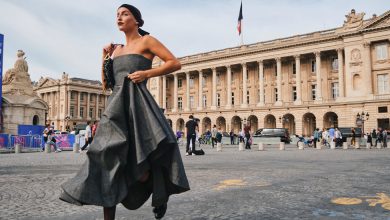Meet the Woman Who Set a Speed Record on a Classic Alpine Ski Route

Valentine Fabre has no reason to doubt her abilities in the mountains. The 45-year-old Frenchwoman helped her country earn two world championships in ski mountaineering, a high-adrenaline endurance sport that involves sprinting up and racing down mountains on skis. She’s also a military-trained doctor with a focus on high-mountain medicine, and a resident of the French Alps for 20 years.
But when Dr. Fabre first started to consider her most recent challenge, she really wasn’t sure she could do it. Her goal was to set a women’s speed record on one of the most storied multiday ski routes in the Alps: the Haute Route, which winds up and down more than 26,000 feet of mountainous landscape and across more than 65 miles of glaciers and remote alpine passes to connect Chamonix, where Dr. Fabre lives, to Zermatt in neighboring Switzerland.
It’s a route that has a special meaning for Dr. Fabre, beyond its near-mythic status among mountaineers. In 2010, her husband, Laurent Fabre, was part of the team that set a new men’s speed record on the Haute Route, completing the itinerary — which takes most experienced skiers six or seven days to do — in just 20 hours and 28 minutes. Two years later, Mr. Fabre, who worked as a high mountain guide, died in a climbing accident outside of Chamonix. Dr. Fabre was on call at the hospital when she got the news.
Last April, almost nine years after her husband’s death, Dr. Fabre — alongside her American teammate Hillary Gerardi — established a women’s speed record on the Haute Route with a time of 26 hours and 21 minutes. Dr. Fabre credits Ms. Gerardi’s enthusiasm for giving her the push she needed to take on the challenge, which was documented in a 34-minute film released in September.
I reached Dr. Fabre at her home in Chamonix a few days before Christmas. She described what it felt like to set the record, why she hopes someone will break it soon, and how — even though she grew up near Paris — she always knew she would make her home in the mountains.
Our conversation has been edited for length and clarity.
What is the Haute Route, and what does it represent in the world of mountaineering?
It’s a ski route that connects the two capitals of French and Swiss mountaineering, Chamonix and Zermatt, going through the high mountains and over glaciers. The itinerary we took was 107 kilometers long (about 66 miles), with 8,100 meters (26,500 feet) of positive elevation gain. There are several variations, but we took the pretty classic high route. Back in the 19th century, I think it was a big challenge — people wanted to connect these two cities, which they first did by foot, groping their way through the valleys, looking for the best way. The route was done on skis for the first time in 1903, and I’m lucky enough to have had access to the photo album that documents that first expedition. They managed to bring along a camera that weighed nearly 42 pounds, and they took some incredible photos. I think it took them about two or three weeks.
What was your first experience on the Haute Route?
I first did it in 2000, when I was a medical student, and again in 2002, with my husband, Laurent, though he wasn’t my husband yet. We did it in the opposite direction that time, Zermatt to Chamonix, and we got to know each other along the way. I was doing an internship as a doctor with the army at the time, and we met when he was a high mountain guide for the army.
When did you first get the idea that you wanted to try to set a women’s speed record on the route?
My husband first tried to set the men’s record in 2008, but he was exhausted and had to stop. Then in 2009, the weather was very bad, and the whole team quit. In 2010, they finally set the record. I was an assistant on each of those attempts. I wanted to do it, but I didn’t necessarily think I had the skills, because for me, those guys were heroes. They were very, very strong and they were men. No woman had done that. It was after Laurent’s death that I really formulated this desire to do something in his memory, and I knew that setting a record on the Haute Route would be the most beautiful tribute I could do for him. But I doubted my ability to achieve it, so time passed and I didn’t go for it. But then I finally got the spark I needed when I started training with Hillary.
So how did you and Ms. Gerardi team up?
It was February or March 2019, and we both did a 1,000-meter vertical ski race. Hillary won, and I came in second. We were waiting for the awards ceremony after the race and my partner, Ben, heard her talking about how she wanted to set a record on the Chamonix-Zermatt route. Ben knew that I had this idea but that I doubted my abilities, so he told me: “That’s exactly the person you need to make a great team.” Hillary is about 10 years younger than me, and I think that age difference means she doesn’t doubt her abilities the way I do. Now, I see women half my age who really believe that women can make a mark and set their own records. There’s a cultural difference too — Americans have a very positive character, always saying, “That’s amazing! Good job!” While we French are more like: “OK, you could have done that better.” Hillary is a trail runner, so she has great endurance. She’s also very versatile in the mountains, very positive and very determined. Once I get into it, I’m determined, too, but I hesitate to start. So I don’t know if I would have ever set this record if I hadn’t met her.
You set the women’s record on the route in April 2021. How did the day go?
We left from the church in Chamonix at 2 p.m. and we arrived at the church in Zermatt at 4:21 p.m. the next day, which was Easter Sunday. There wasn’t a big crowd waiting, just a few family and friends. The snow conditions had deteriorated a bit over the previous week, so we were a little doubtful that we would make it, which is why we hadn’t alerted too many people. When we arrived in Zermatt, no one was really interested in these two exhausted women who were crying their eyes out and throwing themselves into the arms of the few people who were waiting.
And what did it feel like to make it to Zermatt?
It was kind of a volcano of emotions. I was exhausted and so relieved to have finished. I was also very moved because I realized that I had done it: I had made the tribute to my husband. I had done as he had done. I had succeeded in connecting Chamonix to Zermatt on my skis and without assistance. So there was a personal pride, and also powerful thoughts of Laurent. Just after his death, I had the impression that he was with me everywhere, that he was watching over me. It’s thanks to him that I’m doing this sport.
You live in Chamonix now, but you didn’t grow up in the Alps. What drew you to that part of France?
Until the age of 17, I lived in the area around Paris, but as a child I always wanted to live in the mountains. When I was 10, I had a cousin who got married in Chamonix, and while we were there, my father and I took the lift up to the Aiguille du Midi, and I was just amazed and thought, “I would love to live here.” Later, when I was a medical student in Bordeaux, I made a lot of trips to the Pyrenees, and then I did an internship in Chamonix in 2001 and 2002, when I met Laurent. Later, I was able to do some mountain diplomas, which allowed me to get a position accompanying the mountaineers of the military high mountain group. Living in the mountains has always been something inside me, and the training I’ve had has allowed me to come here and stay.
You just finished your active service with the military. Will you still work as a doctor, or turn your attention more fully to the mountains?
I’m going to try to do both — continue to work as a doctor, doing shifts in the emergency department and as a reservist for the military, while also pursuing projects in the mountains. It’s important to me to have both these lines of work, which challenge me in different ways. Being in the mountains requires a lot of intellectual ability — calculating risk, preparing your body, all of that. But, of course, being a doctor is also very intellectual. You have to really consider a diagnosis, make your investigation. It’s also fatiguing in its own way. But for me, both of these activities are really important.
Have you heard of any other women who are trying to break your record on the Haute Route?
So far, I haven’t heard anyone say that they were interested, but we would be so happy if other women came to us. Because it’s not just about keeping the record to ourselves for as long as possible. It’s about inspiring others and helping them achieve it — that’s what I didn’t have.
Paige McClanahan is the host of The Better Travel Podcast.
Follow New York Times Travel on Instagram, Twitter and Facebook. And sign up for our weekly Travel Dispatch newsletter to receive expert tips on traveling smarter and inspiration for your next vacation. Dreaming up a future getaway or just armchair traveling? Check out our 52 Places list for 2021.





